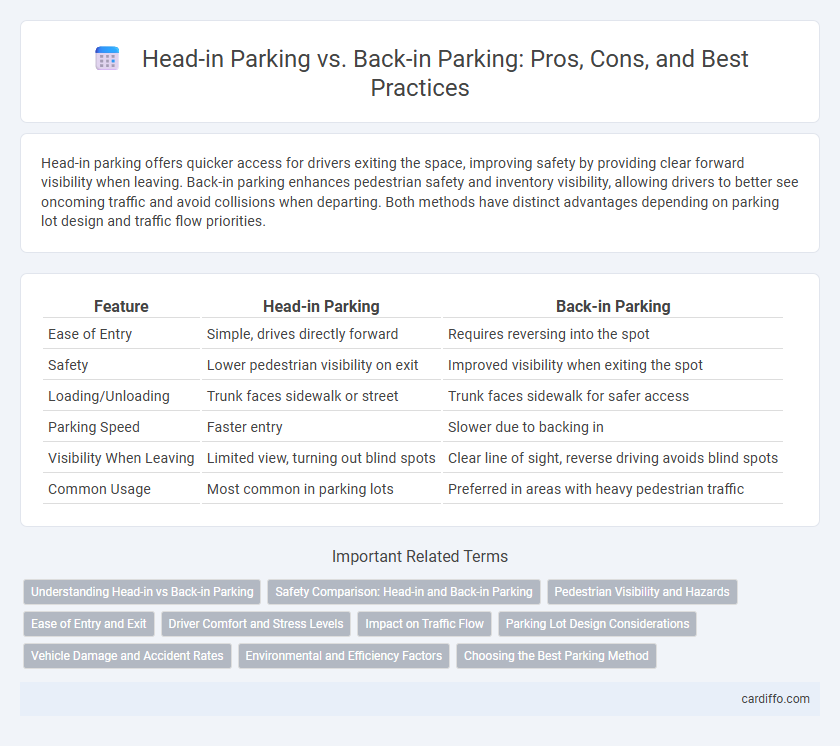Head-in parking offers quicker access for drivers exiting the space, improving safety by providing clear forward visibility when leaving. Back-in parking enhances pedestrian safety and inventory visibility, allowing drivers to better see oncoming traffic and avoid collisions when departing. Both methods have distinct advantages depending on parking lot design and traffic flow priorities.
Table of Comparison
| Feature | Head-in Parking | Back-in Parking |
|---|---|---|
| Ease of Entry | Simple, drives directly forward | Requires reversing into the spot |
| Safety | Lower pedestrian visibility on exit | Improved visibility when exiting the spot |
| Loading/Unloading | Trunk faces sidewalk or street | Trunk faces sidewalk for safer access |
| Parking Speed | Faster entry | Slower due to backing in |
| Visibility When Leaving | Limited view, turning out blind spots | Clear line of sight, reverse driving avoids blind spots |
| Common Usage | Most common in parking lots | Preferred in areas with heavy pedestrian traffic |
Understanding Head-in vs Back-in Parking
Head-in parking involves pulling the vehicle forward into a parking space, offering quicker exits but limited visibility when leaving. Back-in parking requires reversing into the spot, enhancing safety by providing better forward visibility when exiting and easier access to the trunk or side doors. Choosing between these methods depends on factors like traffic flow, parking lot design, and driver comfort with reversing.
Safety Comparison: Head-in and Back-in Parking
Back-in parking improves safety by allowing drivers to have better visibility when exiting a space, reducing the risk of collisions with pedestrians and other vehicles. Head-in parking can limit rear visibility, increasing the chances of backing accidents, especially in crowded lots. Studies show that back-in parking decreases backup crashes by up to 40%, highlighting its advantage in safety performance.
Pedestrian Visibility and Hazards
Back-in parking significantly improves pedestrian visibility by allowing drivers to see approaching pedestrians and cyclists before exiting the vehicle, reducing the risk of collisions. Head-in parking creates blind spots that increase hazards for pedestrians, as drivers often back out without clear sightlines. Enhanced visibility during back-in parking contributes to safer pedestrian environments around parking areas.
Ease of Entry and Exit
Head-in parking allows for quick and straightforward entry, reducing the need for complex maneuvering, which is ideal in tight spaces or high-traffic areas. Back-in parking offers enhanced safety and visibility when exiting, as drivers have a clear forward view of oncoming traffic and pedestrians. Choosing between the two methods depends on prioritizing ease of entry or ease of exit based on the parking environment and driver preference.
Driver Comfort and Stress Levels
Head-in parking often reduces driver discomfort by requiring straightforward alignment and visibility, minimizing stress during entry into a space. Back-in parking, while sometimes challenging at first, can enhance safety and ease when exiting, lowering overall tension by improving rearward visibility and vehicle control. Studies show drivers report lower stress levels post-practice with back-in parking due to increased confidence and comfort in crowded or tight parking environments.
Impact on Traffic Flow
Head-in parking allows for quicker and more straightforward vehicle entry and exit, reducing the time vehicles occupy the traffic lane and enhancing overall traffic flow efficiency. Back-in parking improves safety by increasing driver visibility when departing, which can decrease accidents and minimize disruptions to traffic movement. Urban planning studies indicate that incorporating back-in parking in high-traffic areas can lead to smoother vehicle circulation and fewer traffic jams.
Parking Lot Design Considerations
Head-in parking maximizes space efficiency by allowing vehicles to pull straight into designated stalls, facilitating easier traffic flow and quicker access to storefronts. Back-in parking enhances safety and visibility upon exiting, reducing blind spots and potential collisions in parking lots with high pedestrian activity. Effective parking lot design balances these methods by considering traffic patterns, user convenience, and overall site safety to optimize vehicle movement and space utilization.
Vehicle Damage and Accident Rates
Back-in parking reduces vehicle damage and accident rates by improving driver visibility and control when exiting a space, unlike head-in parking which limits rearward visibility and increases collision risks. Studies indicate that backing into a space allows drivers to better see oncoming traffic and pedestrians, significantly lowering accident occurrences. Insurance data confirms that back-in parking correlates with fewer claims related to minor collisions and parking lot accidents.
Environmental and Efficiency Factors
Back-in parking improves environmental efficiency by reducing the time and fuel wasted during maneuvering, as it allows drivers to position vehicles more quickly and safely. This method enhances visibility when exiting parking spaces, lowering the risk of accidents and subsequent traffic delays, which contributes to smoother traffic flow and reduced emissions. In contrast, head-in parking often requires more adjustments and reversing, leading to increased fuel consumption and greater environmental impact.
Choosing the Best Parking Method
Choosing between head-in parking and back-in parking depends on visibility, safety, and ease of exit. Head-in parking offers quicker entry and is common in standard parking lots, but back-in parking enhances rear visibility when leaving, reducing risk of collisions with pedestrians or other vehicles. Drivers should consider lot design, traffic flow, and personal comfort with maneuvering to select the optimal parking method.
Head-in Parking vs Back-in Parking Infographic

 cardiffo.com
cardiffo.com